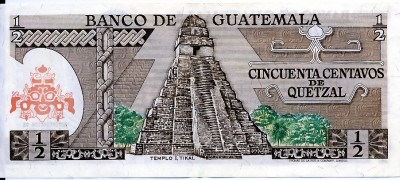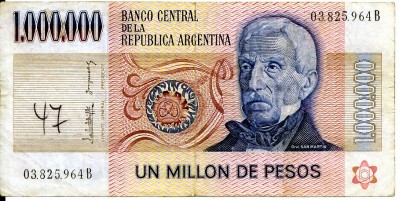 This banknote was issued for 1,000,000 Peso Ley which was Argentina's currency for a number of years until 1983, when the Peso Ley was replaced by the Peso Argentino at a rate of 10,000 to 1. In 1985, the Peso Argentino was replaced by the Austral at the rate of 10,000 to 1. In 1992, the Austral was replaced by the Peso Convertible at a rate of 10,000 to 1. For a number of years the Peso Convertible was on par with the U.S. dollar, but today trades at a bit over 3 to 1. I carefully muliplied this out and today it would take 3,000,000,000,000,000,000 Peso Ley to equal one US dollar. Clearly this bill would not buy me lunch at Olive Garden in Reynoldsburg.
This banknote was issued for 1,000,000 Peso Ley which was Argentina's currency for a number of years until 1983, when the Peso Ley was replaced by the Peso Argentino at a rate of 10,000 to 1. In 1985, the Peso Argentino was replaced by the Austral at the rate of 10,000 to 1. In 1992, the Austral was replaced by the Peso Convertible at a rate of 10,000 to 1. For a number of years the Peso Convertible was on par with the U.S. dollar, but today trades at a bit over 3 to 1. I carefully muliplied this out and today it would take 3,000,000,000,000,000,000 Peso Ley to equal one US dollar. Clearly this bill would not buy me lunch at Olive Garden in Reynoldsburg.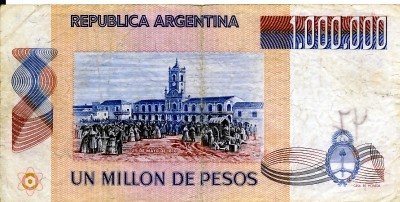
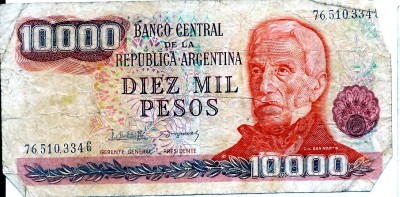 When the change was made from Peso Ley to Peso Argentino, they didn't have the time to have new designs made up. So, they just used the same design but took off four zeroes. Both types of bills were in circulation in 1985, which made life rather interesting when it came to paying for things.
When the change was made from Peso Ley to Peso Argentino, they didn't have the time to have new designs made up. So, they just used the same design but took off four zeroes. Both types of bills were in circulation in 1985, which made life rather interesting when it came to paying for things. 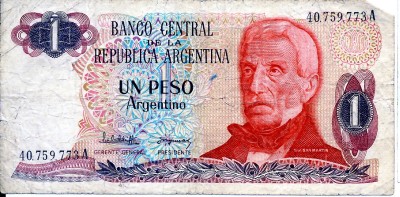
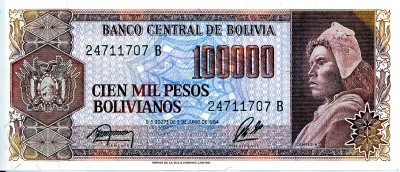
At the beginning of 1982 the Bolivian Peso was worth 25 to the US dollar. Three years later it was about 2,300 to the U.S. dollar. Then things got bad. When I arrived in Bolivia in early June 1985, the peso was trading at 320,000 to the U.S. dollar. A week later the rate was 520,000 to 1, before recovering a few days later to a 500,000 to 1 rate. Because the money was losing value so fast, the government was having a hard time printing currency fast enough. The largest bill in circulation was the 100,000 peso bill. We would exchange a US $20 bill and get 100 of 100,000 peso bills to stuff into our pocket. Then we would go down the street and buy a soft drink for 70,000 pesos, paying with a 100,000 peso bill. However, there was a shortage of bills of 5,000 and 10,000 pesos. So, we would get back 30 bills of 1000 pesos in change, each of which was worth one-fifth of one US cent. Sometimes there wouldn't be enough 1000 pesos bills and we would get some 500 peso bills also.
By September, the exchange had passed 1,000,000 to 1 and finally bottomed out at around 2,000,000 to 1 around the end of the year. In 1986, Bolivia issued a new currency called the Boliviano at a rate of 1 to 1,000,000 of the old pesos, or 2 to 1 US dollar. Since then Bolivia has closely managed its economy by letting its people slide further into poverty as "recommended" by the IMF. Currently the exchange rate is 7 Bolivianos to one US dollar. Just six months ago, it was around 7.5 to 1, so it is not just Euros and Canadian dollars that are gaining on the US dollar.
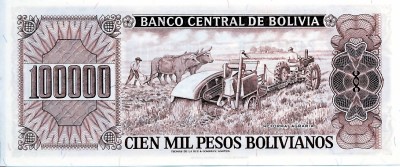
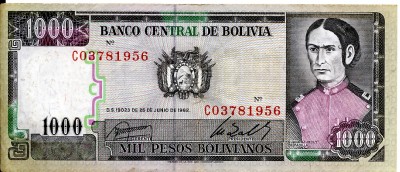 The person on the 1000 peso bill looks to be a rather grim-faced man, but it is actually a woman - Juana Azurday de Padilla, if you check the name. Her husband was a commander in the revolutionary army during the war of independence against Spain. After he was killed, she commanded the army of 6,000 for several years, effectively ruling her own little country in present-day southern Bolivia and nearby Argentina. It is not known if she wore lipstick or hunted moose, but she did lead her troops into battle while pregnant. Perhaps the reason she is not so happy is that she had four sons killed in the fighting. She is considered a hero in both Argentina and Bolivia. In Argentina they named an infantry regiment after her.
The person on the 1000 peso bill looks to be a rather grim-faced man, but it is actually a woman - Juana Azurday de Padilla, if you check the name. Her husband was a commander in the revolutionary army during the war of independence against Spain. After he was killed, she commanded the army of 6,000 for several years, effectively ruling her own little country in present-day southern Bolivia and nearby Argentina. It is not known if she wore lipstick or hunted moose, but she did lead her troops into battle while pregnant. Perhaps the reason she is not so happy is that she had four sons killed in the fighting. She is considered a hero in both Argentina and Bolivia. In Argentina they named an infantry regiment after her.
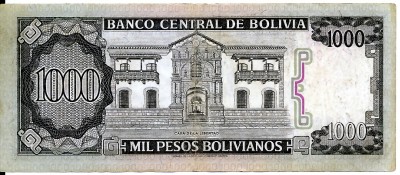
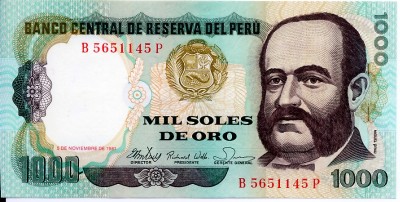 I can't remember much about the Peruvian economic situation, but you can bet this is worth less than a single sheet of Charmin today.
I can't remember much about the Peruvian economic situation, but you can bet this is worth less than a single sheet of Charmin today.
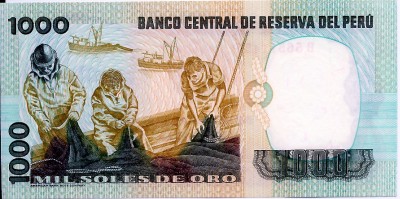
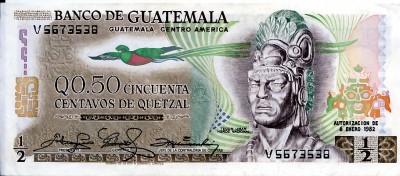 I bet you didn't know that the Guatemalan Quetzal is one of the stronger currencies in Latin America. In the early 1980s the Quetzal was on par with the U.S. dollar - which made this bill worth U.S. 50 cents. Today the exchange rate is about 7 Quetzals to the dollar, which makes it worth about 7 US cents. That makes it worth more than all the above bills combined.
I bet you didn't know that the Guatemalan Quetzal is one of the stronger currencies in Latin America. In the early 1980s the Quetzal was on par with the U.S. dollar - which made this bill worth U.S. 50 cents. Today the exchange rate is about 7 Quetzals to the dollar, which makes it worth about 7 US cents. That makes it worth more than all the above bills combined. 